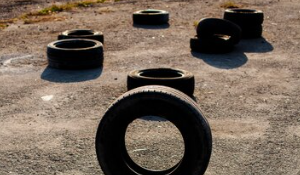With the increasing number of scrap tires, it becomes challenging to manage this huge number of tires. But did you know that tires are recyclable? You can turn old tires into new things by melting them. Melting a tire is a key step in recycling rubber because you can’t recycle without it.
Melting a tire allows you to form it into various pieces for your kitchen sink, exhaust hanger, shoes, playgrounds, wardrobe, and much more. But how can you melt and reuse it? To answer this question let’s discuss this topic in detail.
Understanding Tire Composition
It is important to understand the composition of tires before going through the process of melting. Rubber compounds, such as synthetic and natural rubber, steel, carbon black, and other chemicals, are the main ingredients of tires. Each component gives the tire unique qualities that guarantee resilience, traction, and durability.
The Melting Process: Transforming Tires into Raw Material
Tire Shredding
The first step in tire recycling involves shredding the tires into smaller pieces. Take a tire shredder and shred the tires. Each tire is carefully inserted into the shredder to start the tire shredding process. The machine’s strong blades break into action, quickly cutting through the tire’s rubber and other components and shredding it into smaller pieces. This careful shredding guarantees effective handling and processing of the tire materials in addition to simplifying the final phases of recycling.
Pyrolysis or Thermal Decomposition
Pyrolysis, a thermal decomposition process, is commonly employed to melt down tires. It includes heating materials in an oxygen-free environment. This technique represents a major advancement in recycling technology as it makes it possible to extract original elements from materials like tires.
Traditional pyrolysis has a number of drawbacks. These include the recovered materials’ impurity, the high energy requirements, as well as risk of fire. However, these drawbacks were recovered by a recycling company based in Sweden that introduced an innovative method for handling pyrolysis. They have a closed system design that keeps oxygen out and an innovative energy recycling technology that boosts efficiency.
By carefully controlling oxygen levels, it guarantees the quality of recovered materials, significantly decreases energy usage, and raises safety requirements.
Melting Rubber
Once shredded and processed through pyrolysis, the rubber components of tires can be melted down at high temperatures causing them to liquefy. Once in a molten state, the rubber can be shaped into different forms based on specific requirements. This flexibility allows for the creation of various products, including rubber sheets, pellets, and customized components, depending on the intended use.
Applications of Recycled Tire Products
Recycled tire products are amazing. You can use them in different ways and places, showing how useful and versatile tire recycling is. Here are some of the cool things you can do with recycled tire products:
Asphalt Modification
You can use crumb rubber from melted tires to make asphalt better. It makes asphalt stronger, more flexible, and more resistant to wear and tear. Asphalt roads with recycled rubber last longer and work better, helping to build a greener and safer infrastructure.
Rubberized Mulch
You can use melted tires to make rubberized mulch, which is a great alternative to wood-based mulch. Rubber mulch is better for shock absorption, weed control, and water conservation, making it perfect for playgrounds, gardens, and horse arenas.
Recycled Rubber Products
You can use molten rubber from tire recycling to make different rubber products, such as mats, tiles, athletic surfaces, and car parts. These recycled rubber products are as good as new, but they have less environmental impact.
Environmental and Economic Benefits
The benefits of melting and recycling tires are not restricted only to utilizing them to create new products but they also have positive environmental and financial effects. Let’s review those benefits now:
Reduction of Waste
Millions of tons of scrap tires are kept out of landfills due to tire recycling, which reduces pollution and preserves valuable landfill space. We reduce the impact of tire disposal on the environment by reusing tire waste management.
Preservation of Resources
Reusing tires that have been melted down helps preserve important resources like steel and rubber by lowering the demand for raw materials derived from natural sources. This encourages a circular economic model by increasing resource efficiency and decreasing dependency on limited resources.
Financial Possibilities
Tire recycling initiatives create jobs and stimulate economic growth across the value chain, from collection and processing to manufacturing and distribution.
Communities can take advantage of economic possibilities and support environmental sustainability by investing in infrastructure for tire recycling.




